|
What Happened to the American Economy?
October 2009
Official U.S. unemployment rate jumped to 10.2%.
search
June 1, 2009
GM
bankruptcy announced. search
April
30, 2009
Chrysler
bankruptcy announced. search
Sept.
19, 2008
Treasury announces guaranty program for money market funds. search
Sept.
18, 2008
Run on money
markets.
search
Sept.
15, 2008
Lehman Brothers filed for Chapter 11 bankruptcy (case
study). search
Sept.
7, 2008
Federal takeover of
Fannie
Mae and Freddie Mac, a conservatorship. search
July
17, 2007
Bear
Stearns High-Grade Structured Credit Funds collapse
(House
of Cards).
search
A
Massive Economic Contraction!
Contraction in Percentage of U.S.
Civilian Population Employed
and U.S. Housing Starts


Why did this happen?
The economic contraction occurred
because of poor risk management during the liberalization of financial markets.
There were too many unwise steps
taken to reduce capital reserves for potentially high-risk loans.
Capital reserves are the money that banks and other financial
institutions must keep on hand as a cushion against losses.
| Brokerage
Firms |
Government Sponsored Enterprises
(GSE) |
Banks |
| NEW
RULES
April 28, 2004
U.S. market regulators approved new rules that would let some major Wall Street brokerages reduce the amount of money they set aside as net capital, in some cases by as much as 30 percent. In a move in line with bank regulatory changes in Europe, the U.S. Securities and Exchange Commission voted unanimously in an open meeting to approve two optional sets of rules. Under one of them, five big U.S. brokerages
could be designated as "consolidated supervised entities," or
CSEs.
Goldman Sachs, Morgan Stanley, Merrill Lynch, Lehman Brothers and Bear Stearns
expressed interest in CSE status. In line with new capital adequacy standards coming into force soon under Europe's Basel accords, brokerages granted CSE status would be able to use in-house, risk-measuring computer models to figure how much net capital they need to set aside. Under Basel standards, some institutions could
cut their net capital by as much as 50 percent. But the SEC's new CSE rule added a $5-billion floor to the Basel model, reducing the likely level of reductions to 20 to 30 percent.
source | search
AFTER THE FALL
September 26, 2008
Securities and Exchange Commission Chairman Christopher Cox today announced a decision by the Division of Trading and Markets to end the Consolidated Supervised Entities (CSE) program, created in 2004 as a way for global investment bank conglomerates that lack a supervisor under law to voluntarily submit to regulation. Chairman Cox also described the agency's plans for enhancing SEC oversight of the broker-dealer subsidiaries of bank holding companies regulated by the Federal Reserve, based on the recent Memorandum of Understanding (MOU) between the SEC and the Fed.
Chairman Cox made the following statement:
The last six months have made it abundantly clear that voluntary regulation does not work. When Congress passed the Gramm-Leach-Bliley Act, it created a significant regulatory gap by failing to give to the SEC or any agency the authority to regulate large investment bank holding companies, like Goldman Sachs, Morgan Stanley, Merrill Lynch, Lehman Brothers, and Bear Stearns.
Because of the lack of explicit statutory authority for the Commission to require these investment bank holding companies to report their capital, maintain liquidity, or submit to leverage requirements, the Commission in 2004 created a voluntary program, the Consolidated Supervised Entities program, in an effort to fill this regulatory gap.
As I have reported to the Congress multiple times in recent months, the CSE program was fundamentally flawed from the beginning, because investment banks could opt in or out of supervision voluntarily. The fact that investment bank holding companies could withdraw from this voluntary supervision at their discretion diminished the perceived mandate of the CSE program, and weakened its effectiveness.
The Inspector General of the SEC today released a report on the CSE program's supervision of Bear Stearns, and that report validates and echoes the concerns I have expressed to Congress. The report's major findings are ultimately derivative of the lack of specific legal authority for the SEC or any other agency to act as the regulator of these large investment bank holding companies.
With each of the major investment banks that had been part of the CSE program being reconstituted within a bank holding company, they will all be subject to statutory supervision by the Federal Reserve. Under the Bank Holding Company Act, the Federal Reserve has robust statutory authority to impose and enforce supervisory requirements on those entities. Thus, there is not currently a regulatory gap in this area.
The CSE program within the Division of Trading and Markets will now be ending.
source | search
|
NEW
RULES
March 19, 2008
OFHEO, Fannie Mae
and Freddie Mac today announced a major initiative to increase
liquidity in support of the U.S. mortgage market. The
initiative is expected to provide up to $200 billion of
immediate liquidity to the mortgage-backed securities
market.
OFHEO estimates that Fannie Mae’s
and Freddie Mac’s existing capabilities, combined with this
new initiative and the release of the portfolio caps announced
in February, should allow the GSEs to purchase or guarantee
about $2 trillion in mortgages this year. This capacity will
permit them to do more in the jumbo temporary conforming
market, subprime refinancing and loan modifications
areas.
To support growth and further
restore market liquidity, OFHEO announced that it would begin
to permit a significant portion of the GSEs’ 30 percent
OFHEO-directed capital surplus to be invested in mortgages and
MBS.
source
| search
AFTER THE FALL
September 7, 2008
In order to restore the
balance between safety and soundness and mission, FHFA has
placed Fannie Mae and Freddie Mac into conservatorship. That
is a statutory process designed to stabilize a troubled
institution with the 5 objective of returning the entities to
normal business operations. FHFA will act as the conservator
to operate the Enterprises until they are stabilized.
The goal of these actions is to
help restore confidence in Fannie Mae and Freddie Mac, enhance
their capacity to fulfill their mission, and mitigate the
systemic risk that has contributed directly to the instability
in the current market.
source
| search
|
NEW
RULES
1980-1992
The Monetary
Control Act of 1980 (MCA) mandated universal reserve
requirements to be set by the Federal Reserve for all
depository institutions, regardless of their membership
status.
To ease the burden of reserve
requirements, the MCA initially set the basic reserve
requirement on transaction deposits at 12 percent — below
the 16.25 percent maximum that had been in effect for member
banks — and prohibited the Federal Reserve from raising this
requirement above 14 percent. It also set a 3 percent reserve
requirement on the first $25 million of deposits at each
institution — the so-called low reserve tranche — as a
special concession to smaller depositories.
In 1982, the Garn–St Germain
Act went even further by exempting from reserve requirements
altogether the first $2 million of deposits. The law mandated
annual adjustments to the cutoffs for the exemption and the
low reserve tranche based on aggregate growth in reservable
liabilities and transaction deposits respectively. To help
smooth the transition for nonmember banks and thrift
institutions, a multiyear phase-in period was put in place,
and the Federal Reserve was also prohibited from putting
reserve requirements on personal time and savings deposits,
which were particularly important sources of funds for these
institutions.
In the decade after passage of
the MCA in 1980, the Federal Reserve left reserve requirements
essentially unchanged. More recently, however, it has taken
two steps to reduce these requirements. In December 1990, the
required reserve ratio on nontransaction accounts —
nonpersonal time and savings deposits and net Eurocurrency
liabilities — was pared from 3 percent to zero, and in April
1992, the 12 percent requirement on transaction deposits was
trimmed to 10 percent.
source
| search
1994-2008
Since 1994,
depository institutions have been able to lower required
reserves without affecting customer liquidity by periodically
reclassifying balances from retail transactions deposits into
savings accounts. This practice, known as
"sweeping," has grown rapidly, and, as a result,
reserve requirements as a percentage of total liquid deposits
have fallen dramatically.
source
Since January 1994, the Federal
Reserve Board has permitted depository institutions in the
United States to implement so-called retail sweep programs.
The essence of these programs is computer software that
dynamically reclassifies customer deposits between transaction
accounts, which are subject to statutory reserve requirement
ratios as high as 10 percent, and money market deposit
accounts, which have a zero ratio. Through the use of such
software, hundreds of banks have sharply reduced the amount of
their required reserves. In some cases, this new level of
required reserves is less than the amount that the bank
requires for its ordinary, day-to-day business. In the
terminology introduced by Anderson and Rasche (1996b), such
deposit-sweeping activity has allowed these banks to become
“economically nonbound,” and has reduced to zero the
economic burden (“tax”) due to statutory reserve
requirements.
source
Bank reserves
effectively near zero for over a decade.

Required Reserves minus Vault Cash
source
During the 1990s,
Federal Reserve publications have documented the spread of
deposit-sweeping software through the U.S. banking industry.
The July 1994 Humphrey-Hawkins Act monetary-policy report
introduced deposit-sweep programs, in a single sentence. The
July 1995 report noted that approximately $12 billion of
deposits were involved in sweep activity and, as a result,
that deposits at Federal Reserve Banks had decreased by about
$1.2 billion. It also raised concern regarding an increase in
federal funds rate volatility if deposits decreased further.
The July 1996 report included a special appendix on the
operation of sweep programs. The February 1997 report noted
that the aggregate amount of deposits affected by sweep
programs had increased to approximately $116 billion, compared
to $45 billion in 1995. The July 1997 report noted the
introduction of deposit-sweep programs for household demand
deposits, and noted that some banks were increasing the size
of their clearing balance contracts when sweep programs
reduced their required reserves. Subsequent reports have
repeated these themes, along with an appeal that the Congress
allow the Federal Reserve to pay interest on reserve balances.
source
| search
AFTER THE FALL
October 6, 2008
The Federal Reserve Board
announced that it will begin to pay interest on depository
institutions' required and excess reserve balances.
The Financial Services
Regulatory Relief Act of 2006 originally authorized the
Federal Reserve to begin paying interest on balances held by
or on behalf of depository institutions beginning October 1,
2011. The recently enacted Emergency Economic Stabilization
Act of 2008 accelerated the effective date to October 1, 2008.
Employing the accelerated
authority, the Board has approved a rule to amend its
Regulation D (Reserve Requirements of Depository Institutions)
to direct the Federal Reserve Banks to pay interest on
required reserve balances (that is, balances held to satisfy
depository institutions' reserve requirements) and on excess
balances (balances held in excess of required reserve balances
and clearing balances).
The interest rate paid on
required reserve balances will be the average targeted federal
funds rate established by the Federal Open Market Committee
over each reserve maintenance period less 10 basis points.
Paying interest on required reserve balances should
essentially eliminate the opportunity cost of holding required
reserves, promoting efficiency in the banking sector.
The rate paid on excess
balances will be set initially as the lowest targeted federal
funds rate for each reserve maintenance period less 75 basis
points. Paying interest on excess balances should help to
establish a lower bound on the federal funds rate. The formula
for the interest rate on excess balances may be adjusted
subsequently in light of experience and evolving market
conditions.
source
| search
|
What was done to
address the economic contraction in 2008?
The
monetary base was increased to cover the dangerous lack of capital reserves.
The U.S. Treasury created billions of
additional dollars, and the Federal Reserve used the dollars to
purchase high-risk loans from financial institutions, and provided
overnight loans as needed, to keep the institutions solvent.
Massive Increase in the Monetary Base
since 2008

Monetary Base (dollars in circulation
and central banks' reserves) source
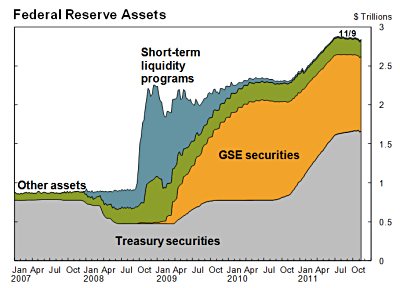
Federal Reserve Assets 2007-2011 source
After the collapse of
Lehman Brothers in 2008, the Federal Reserve rapidly increased the monetary base to
fund a variety of short-term programs to stabilize financial institutions by
providing them with much needed reserves. Included were programs supporting
banks, money market mutual funds, and primary dealers (Goldman Sachs, Morgan Stanley, Merrill
Lynch, etc.)
[see Chart D below]. Funds were also used to support
foreign central banks through currency swaps. In 2009, as funding
for the short-term programs was reduced, a massive transfer of
high-risk ("toxic") mortgage-backed securities to the
Federal Reserve occurred to provide banks with more excess reserves
[see Charts D & E
below].
High Excess Reserves of Depository Institutions
since 2008

Excess Reserves of Depository Institutions
source
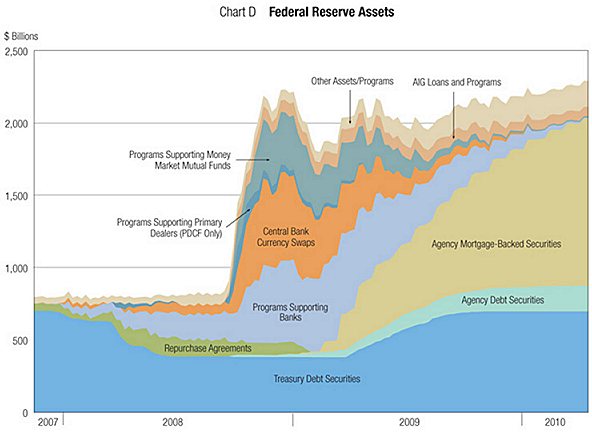
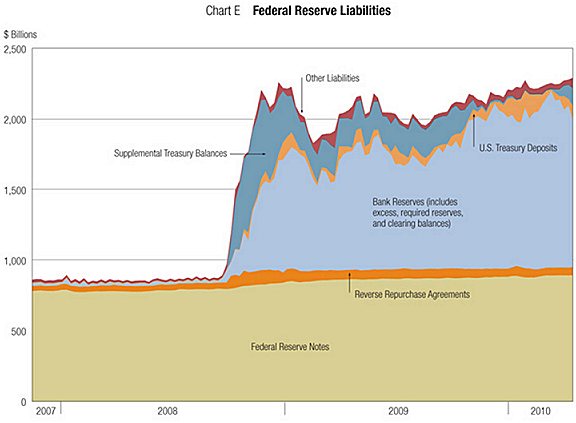

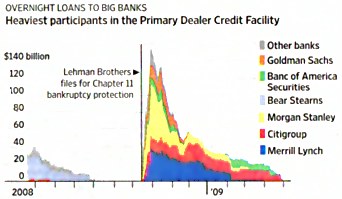
60 Minutes Asks Why Isn't
Anybody in Jail for the Financial Crisis?
source
Why all the risky
loans?
The desire for "affordable" home
loans was a key component of the economic contraction in 2008.
High-risk
mortgage loans were pushed by a do-gooder federal government, and
accepted by many borrowers and lenders.
As long as home values continued to increase, the high risks of many mortgage loans
were
"hidden" from view. Once home prices began to fall in
2007, an economic contraction was just around the corner.
U.S. House Price
Index

House Price Index for the U. S.
source
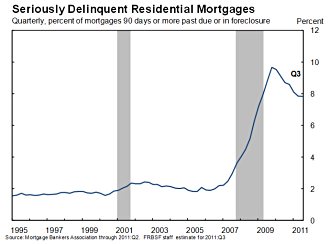
What were borrowers and lenders
thinking?
|
Mortgage
Borrowers
|
Federal
Government
|
Mortgage
Lenders |
|
A 20% mortgage loan down
payment is "not fair".
Historically, mortgage
borrowers were required to make a 20% down payment. The lender
was protected from any potential loss in the mortgaged home
value by lending out only 80% of the selling price.
Many mortgage borrowers would
like to avoid a 20% down payment, especially if they are
first-time or low-income home buyers, and they were happy when
mortgage lending practices changed to include...
NINA loans
A type of reduced documentation mortgage program in which no
income and no assets are disclosed on the loan application,
but employment is verified.
NINJA loans
A type of loan extended to a borrower with "no income, no
job and no assets".
For comparison, risk-averse lenders would require the
borrower to verify a stable income and sufficient collateral,
but a NINJA loan process ignores such verification.
125% loans
A mortgage loan with a borrowed amount equal to 125% of the
initial property value. The borrower gets a mortgage loan with
no down payment, and with an addition loaned amount for 25% of
the value of the property being mortgaged.
|
Federal
government "stability", "assistance" and
"access" is created.
The Federal
National Mortgage Association, nicknamed Fannie Mae, and the
Federal Home Mortgage Corporation, nicknamed Freddie Mac, have
operated since 1968 as government sponsored enterprises (GSEs).
This means that, although the two companies are privately
owned and operated by shareholders, they are protected
financially by the support of the Federal Government. These
government protections include access to a line of credit
through the U.S. Treasury, exemption from state and local
income taxes and exemption from SEC oversight.
Fannie Mae was created in 1938 as part of Franklin Delano Roosevelt's New Deal.
Initially, Fannie Mae operated
like a national savings and loan, allowing local banks to
charge low interest rates on mortgages for the benefit of the
home buyer. This lead to the development of what is now known
as the secondary mortgage market. Within the secondary
mortgage market, companies such as Fannie Mae are able to
borrow money from foreign investors at low interest rates
because of the financial support that they receive from the
U.S. Government. It is this ability to borrow at low rates
that allows Fannie Mae to provide fixed interest rate
mortgages with low down payments to home buyers. Fannie Mae
makes a profit from the difference between the interest rates
homeowners pay and foreign lenders charge.
For the first thirty years
following its inception, Fannie Mae held a veritable monopoly
over the secondary mortgage market. In 1968, due to fiscal
pressures created by the Vietnam War, Lyndon B. Johnson
privatized Fannie Mae in order to remove it from the national
budget. At this point, Fannie Mae began operating as a GSE,
generating profits for stock holders while enjoying the
benefits of exemption from taxation and oversight as well as
implied government backing. In order to prevent any further
monopolization of the market, a second GSE known as Freddie
Mac was created in 1970. Currently, Fannie Mae and Freddie Mac
control about 90 percent of the nation's secondary mortgage
market.
source
FEDERAL
HOME LOAN MORTGAGE CORPORATION ACT
Approved July 24, 1970
As amended through July 21, 2010
It is the purpose
of the Federal Home Loan Mortgage Corporation—
(1) to provide
stability in the secondary market for residential
mortgages;
(2) to respond
appropriately to the private capital market;
(3) to provide
ongoing assistance to the secondary market for residential
mortgages (including activities relating to mortgages on
housing for low- and moderate-income families involving a
reasonable economic return that may be less than the return
earned on other activities) by increasing the liquidity of
mortgage investments and improving the distribution of
investment capital available for residential mortgage
financing; and
(4) to promote
access to mortgage credit throughout the Nation (including
central cities, rural areas, and underserved areas) by
increasing the liquidity of mortgage investments and improving
the distribution of investment capital available for
residential mortgage financing.
source
"I do think I
do not want the same kind of focus on safety and soundness
that we have in OCC [Office of the Comptroller of the
Currency] and OTS [Office of Thrift Supervision]. I want to
roll the dice a little bit more in this situation towards
subsidized housing"
-- Rep. Barney Frank,
House Financial Services Committee hearing, Sept. 25, 2003
|
Mortgage Loan
Reselling Historically,
most mortgage companies and banks serviced their mortgage
loans after they originated them. Before making a loan, they
took into account a potential borrower’s financial status
and history, spending habits, and existing relationship with
the lender, if there was one. Each lender had a great
incentive to see that the mortgage was repaid in full and on
time. More recently,
it has become common for loan originators to quickly resell
their mortgage holdings to companies that specialize in
servicing mortgage loans. In some cases, a mortgage loan is
resold several times. Resold mortgages are often packaged into
mortgage-backed securities (MBS). The
practice of reselling mortgages can foster a higher level of
risk taking on the part of the lender, since the loan
originator can be less concerned with the loan repayment, as
they do not hold the loan very long. The repayment risk is
passed on to the business servicing the loan after it is
resold. Also,
about 90 percent of the mortgages written in the past few
years are backed by the federal government — mainly through
Fannie, Freddie or the Federal Housing Administration —
which implies that some loan risk can be shifted to the
government (in extreme cases). The
other 10 percent of mortgage loans are typically loans that
are too large to be covered by government programs, or loans
that the lenders decided to keep on their books for some other
reason. Such lenders include community banks and credit unions
— two types of institutions that have long embraced an
old-fashioned, common-sense approach to mortgage lending. |
Why the BIG reduction in home prices?
A price
"bubble" starts with an exuberant rise from strong demand, which is then
followed by an unplanned fall during weak demand.
For several years
after 2000 the rise in U.S. home prices outpaced the historical
norm, but in 2007 prices started to drop toward that norm.
U.S. House Price
Index
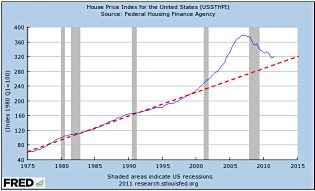
Red dashed line is estimate of
historical norm.
Why did the BIG reduction in home
prices damage the U.S. economy so much?
|
Equity Losses
|
Job Losses
|
Leveraged
Losses |
| A dramatic
fall in home equity.
Perhaps the most defining
aspect of the 2007 recession, and by many considered to be the
origin of the financial crisis, has been the decline in the
housing market.
An important consequence of the
initial increase and subsequent fall in average house prices
for households is the dramatic fall in home equity.
When home prices began to fall
in 2007, owners’ equity in household real estate began to
fall rapidly from almost $13.5 trillion in 1Q 2006 to a little
under $5.3 trillion in 1Q 2009, a decline in total home equity
of over 60%.
With the loss in home equity, a
growing proportion of homeowners in fact lost all equity in
their homes, finding the mortgage debt on their property to
exceed its current market value.
Among homeowners with
mortgages, at the end of 2009, 21% reported to be “underwater”
at the time of the survey.
source |
Employment in the U.S. dropped in
part due the loss of construction jobs, adding to the earlier loss
of jobs in manufacturing.
Shortly after home prices peaked in
2007, the number of new houses being built dropped dramatically.
This resulted in a massive loss of construction jobs.

U.S. Housing Starts
This contraction in construction jobs
was devastating when added to the already massive loss of
manufacturing jobs that occurred shortly after 2000.
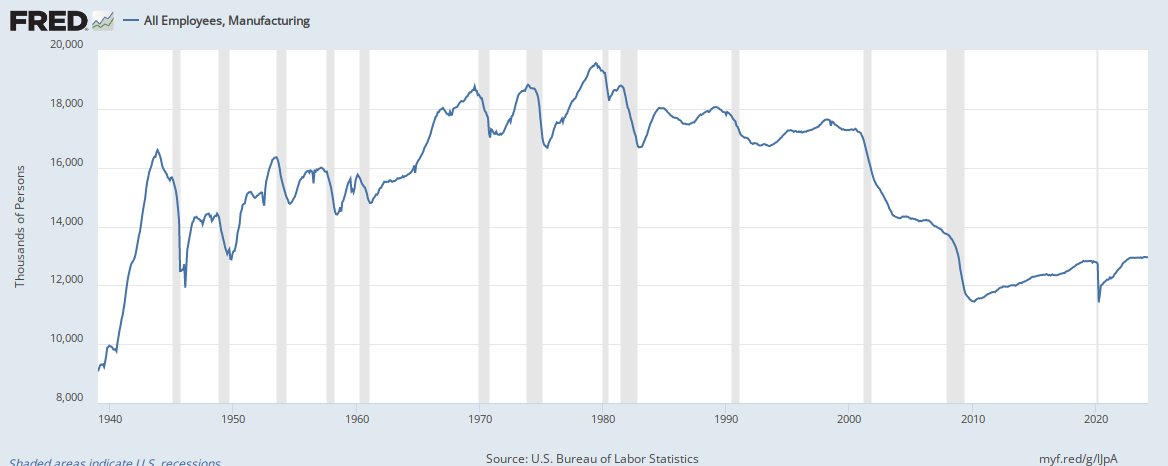
U.S. Manufacturing Jobs
|
A
“post-securitization” credit crisis
The current crisis has the
distinction of being the first “post-securitization”
credit crisis, and so it has many unfamiliar features.

source
Unlike the LTCM crisis of 1998
or the stock market crash of 1987, which bore the hallmarks of
crises driven by a collapse of confidence, the current crisis
has its roots in the credit losses of leveraged financial
intermediaries. Liquidity injections by the central bank are
an invitation to the financial intermediaries to expand their
balance sheets by borrowing from the central bank for
on-lending to other parties. However, a leveraged institution
suffering a shortage of capital will be unwilling to take up
such an invitation. Recognition of this reluctance is the key
to understanding the protracted turmoil we have witnessed in
the interbank market.
Mortgages and asset-backed
securities built on mortgage assets are held in large
quantities by leveraged institutions — by the broker-dealers
themselves at the warehousing stage of the securitization
process, by hedge funds specializing in mortgage securities,
and by the off-balance-sheet vehicles that the banks had set
up specifically for the purpose of carrying the mortgage
securities and the collateralized debt obligations that have
been written on them.
SIVs (structured investment
vehicles) have played an important role in the current crisis.
Conduits and SIVs were designed to hold mortgage-related
assets funded by rolling over short-term liabilities such as
asset-backed commercial paper (ABCP). However, during the
initial stages of the crisis (roughly mid-August 2007), they
began to experience difficulties in rolling over their ABCP
liabilities. Many of the off-balance-sheet vehicles had been
set up with back-up liquidity lines from commercial banks, and
such liquidity lines were beginning to be tapped by
mid-August.
As credit lines were tapped,
the balance sheet constraint at the banks must have begun to
bind, making them more reluctant to lend. In effect, the banks
were “lending against their will.” The fact that bank
balance sheets did not contract is indicative of this
involuntary expansion of credit. One of the consequences of
such an involuntary expansion was that banks sought other ways
to curtail lending. Their natural response was to cut off, or
curtail, lending that was discretionary. The seizing up of the
interbank credit market can be seen as the conjunction of the
desired contraction of balance sheets and the “involuntary”
lending due to the tapping of credit lines by distressed
entities.
Other factors, such as concerns
over counterparty risk and the hoarding of liquidity in
anticipation of new calls on the capital of the bank would
certainly have exacerbated such trends. However, the
hypothesis of an “involuntary” extension of credit appears
important in explaining some of the salient features of recent
credit market events.
source
Financial markets perform the
essential economic function of channeling funds to those who
have productive investment opportunities (which can include
consumer purchases of goods and houses). ...this function of
financial markets is critical to a well-functioning economy;
without it, countries, and their populations, cannot get rich.
Enabling financial markets to effectively perform this
essential function is by no means easy; financial markets must
solve information problems to ensure that funds actually go to
those with productive investments, so that they can pay back
those who have lent to them. Financial development involves
innovations or liberalization of financial markets that
improve the flow of information. Unfortunately, however,
financial liberalization and innovation, often have flaws and
do not solve information problems as well as markets may have
hoped they would. When these flaws become evident, financial
markets sometimes seize up, often with very negative
consequences for the economy.
...we have been experiencing
exactly such a cycle in recent years. Advances in information
and communications technology have allowed for faster and more
disaggregated mortgage underwriting decisions. A mortgage
broker with an Internet connection could quickly fill out an
online form and price a loan for a customer with the help of
credit-scoring technology. The same technological improvements
would allow the resulting loan to be cheaply bundled with
other mortgages to produce mortgage-backed securities, which
could then be sold off to investors. Advances in financial
engineering could take the securitization process even further
by aggregating slices of mortgage-backed securities into more
complicated structured products, such as collateralized debt
obligations (CDOs), to tailor the credit risks of various
types of assets to risk profiles desired by different kinds of
investors.
As has been true of many
financial innovations in the past, the benefits of this
disaggregated originate-to-distribute model may have been
obvious, but the problems less so. The originate-to-distribute
model, unfortunately, created some severe incentive problems,
which are referred to as principal-agent problems, or more
simply as agency problems, in which the agent (the originator
of the loans) did not have the incentives to act fully in the
interest of the principal (the ultimate holder of the loan).
Originators had every incentive to maintain origination
volume, because that would allow them to earn substantial
fees, but they had weak incentives to maintain loan quality.
When loans went bad, originators lost money, mainly because of
the warranties they provided on loans; however, those
warranties often expired as quickly as ninety days after
origination. Furthermore, unlike traditional players in
mortgage markets, originators often saw little value in their
charters, because they often had little capital tied up in
their firm. When hit with a wave of early payment defaults and
the associated warranty claims, they simply went out of
business. While the lending boom lasted, however, originators
earned large profits.
Many securitizers of
mortgage-backed securities and resecuritizers, such as CDO
managers, also, in retrospect, appear to have been motivated
more by issuance and arrangement fees and less by concern for
the longer-run performance of these securities.
source
Crisis
Compels Economists To Reach for New Paradigm
The
Leverage Cycle
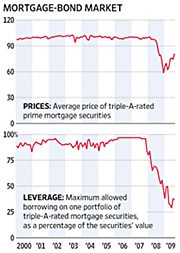
source
|
|
|
Why all the
U.S. debt?
Watch this... Video
1, 2,
3,
4,
5,
6,
7,
8,
9
see... Money
As Debt, II,
III,
IV

Federal Government Debt: Total Public Debt
source
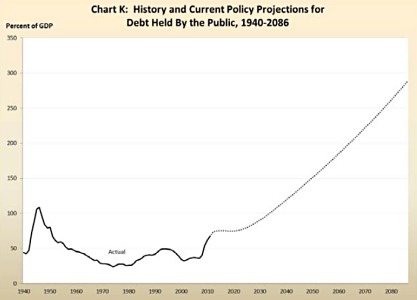
U.S. Debt held by the public as a
percentage of GPD source
|
|
Follow the
Money...
What
in the world is going on?
Wealth is
leaving the U.S. |
|
1.)
Dollars flow from U.S.
to petroleum-exporting nations.
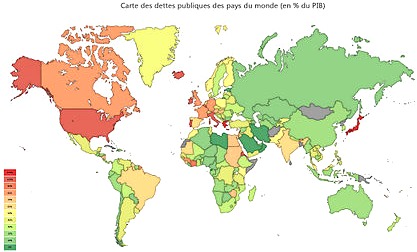
Public debt as a percent of GDP
(2011) map
source
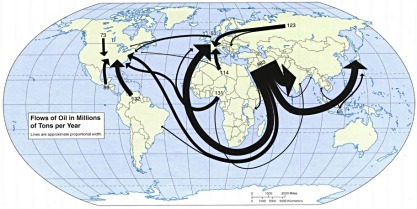
Flows of Oil map
source | petroleum
exporter list
|
|
and
|
|
2.)
Dollars flow from U.S.
to merchandise-exporting nations.

Foreign currency reserves and gold
minus external debt (2010) map
source
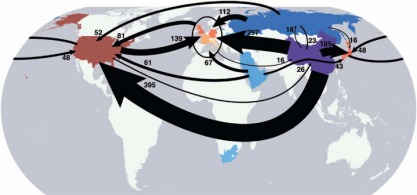
Flow of Manufactured Goods (2004) map
source | merchandise
exporter list
|
|
and
What
is going on in the U.S.?
Wealth is
being transferred inside the U.S.
|
|
3.)
Dollars flow
into U.S. social
welfare programs,
which were initiated as part of the New Deal
resulting from
the progressive
movement (Hoover,
Roosevelt,
Johnson)
and the so-called second
Bill of Rights.
Social
Security Deficits
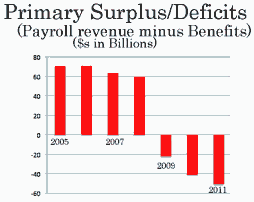
Social Security Primary
Surplus/Deficits (2005-2011)
source
Medicare
Deficits
Medicare
Surplus/Deficits
(Income minus
Expenditures)
($s in Billions)

Medicare
Surplus/Deficits (2005-2010)
source |
|
What about the GDP?
|
|